
Observations and Conclusions
Things Aren’t Always What They Seem to Be.

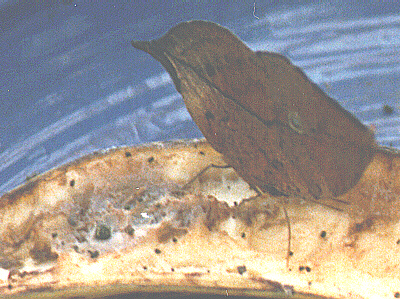 What do you see in the photo, above? What do you see in the photo to the
right? Now, think about each of those photos. Is what you think you’re
seeing actually what’s going on in that picture, or might you have drawn a
conclusion, ahead of time, about what you thought you should be seeing
in each case? For example, how many flowers do you see in the photo, above?
In science, it’s important to train your mind to draw conclusions based on
what you see, rather than seeing based on an assumption/conclusion.
What do you see in the photo, above? What do you see in the photo to the
right? Now, think about each of those photos. Is what you think you’re
seeing actually what’s going on in that picture, or might you have drawn a
conclusion, ahead of time, about what you thought you should be seeing
in each case? For example, how many flowers do you see in the photo, above?
In science, it’s important to train your mind to draw conclusions based on
what you see, rather than seeing based on an assumption/conclusion.
The “Real” Stories on These Photos
 Here’s a close-up of the left-hand edge of the top photo. Notice that each
of what appears to be a “petal” has five small tips on it. It turns out that
each of those tips is, in fact, the tip of a petal, and those five
petals of that one flower are united such that at their base they
form a short tube which, then, expands into the flat part that you see.
Here’s a close-up of the left-hand edge of the top photo. Notice that each
of what appears to be a “petal” has five small tips on it. It turns out that
each of those tips is, in fact, the tip of a petal, and those five
petals of that one flower are united such that at their base they
form a short tube which, then, expands into the flat part that you see.

Also, in the top photo, notice that the curly reproductive
parts arise from “all over,” and not just in the center. In fact, each of
those reproductive structures arises from its own flower, each of
which is surrounded by its own set of five petals as just described. Here’s
a close up of one of the individual flowers. The dandelion at the top of
this page is, then, actually a head made up of a whole bunch of small
flowers (sometimes referred to as “florets”) all grouped together.
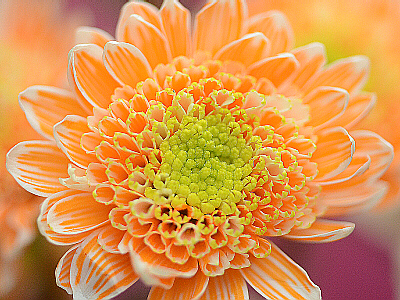 Here’s a photo of a head, a group of flowers, from a closely-related plant.
Can you distinguish the individual flowers and their five petals?
Here’s a photo of a head, a group of flowers, from a closely-related plant.
Can you distinguish the individual flowers and their five petals?
What about the second picture, above? Other than a really
raunchy banana slice sitting in a blue dish, there’s obviously “something”
on the banana. It looks sort-of like a dead leaf, but it’s upright. It
looks sort-of like some kind of bird with its head/beak on the upper left,
but there’s no eye on what appears to be its head. Also, there’s nothing
under it that looks like bird-type feet. . . but if you look/observe very
carefully under it, you may spot five, “thread-like things” sticking out:
two straight ones that are somewhat parallel going to the right, one crooked
one coming out towards us,
and two that are bent in the middle and are sort-of going to the left. In
the middle, there’s a yellowish spot that looks kind of like it might be a
hole in the leaf, but it also reminds me of similar-looking spots I’ve seen
on the wings of various kinds of moths and butterflies. Also, I think I see
a line running from the notch along the top edge, down to the middle bottom
that resembles the front edge of the hindwing of a butterfly. Come to think
of it, the bent “thread-like things” to the left and under it do look rather
like butterfly legs and the straight ones on the right do look like antennae.
Based on my observations, I’m going to draw the tentative
conclusion that this appears to be a Dead Leaf Butterfly with its head
on the lower right and its “back end” raised up on the left side (perhaps I
could go online and look for other Dead Leaf Butterfly photos with which to
compare this one). Too bad this is only a photograph — if you had been there
with me at Callaway Gardens in Pine Mountain, GA when I took this photo, you
might have been able to get a closer look from several directions and see if
it moved or just stayed there.
A Couple Other Examples
 |
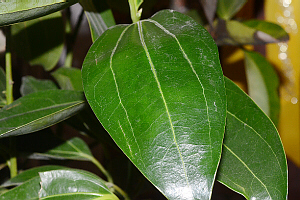 |
Recently, I saw this plant for sale in the house-plant section
of a local hardware store, and immediately, the unusual leaf venation caught
my attention. I remembered that years ago, I once had ordered a tree sapling
from an exotic plant nursery, and it had the same, unusual leaf venation.
That led me to the hypothesis that perhaps this was the same kind of tree.
I looked at
the tag, but all it said was that this was a house plant. I asked an employee,
but he didn’t know what it was. It turns out that right then, there was also
an employee from the plant grower/supplier there, too, and she didn’t know
what it was, either. I mentioned to the store employee what I thought it
might be, he found an inconspicuous, “safe” place and gently scratched
the bark with his fingernail, and we both smelled it. So, observation #2:
the bark smelled like cinnamon. Thus, when the tree and I got home, I did
a Google search, looked at some other photos online, and read what Wikipedia
and several other Web sites had to say. Based on all those observations, I
came to the conclusion that, indeed, this tree is a cinnamon tree (although
I’m not sure exactly which of several, closely-related species).
 A common sight in autumn in this part of the country is Osage Orange fruits
scattered on the roadside. Several years ago, as I was staring at one of
these, I realized there is a very precise pattern to the way in which the
“bumps” are organized on an Osage Orange fruit. In chemistry, you may have
learned about closest packing of spheres, where each atom usually
has six nearest neighbors, and that “rule” also holds true for the cells in
our tissues, but Osage Orange fruit is organized quite differently.
A common sight in autumn in this part of the country is Osage Orange fruits
scattered on the roadside. Several years ago, as I was staring at one of
these, I realized there is a very precise pattern to the way in which the
“bumps” are organized on an Osage Orange fruit. In chemistry, you may have
learned about closest packing of spheres, where each atom usually
has six nearest neighbors, and that “rule” also holds true for the cells in
our tissues, but Osage Orange fruit is organized quite differently.
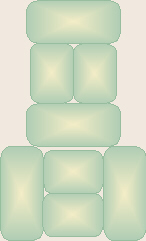
 The “bumps” on an Osage Orange fruit are organized in sets of four, with two
in the middle, and one on each end of a group. Adjacent groups are often
oriented at right angles to each other.
The “bumps” on an Osage Orange fruit are organized in sets of four, with two
in the middle, and one on each end of a group. Adjacent groups are often
oriented at right angles to each other.
To Think About
So often in scientific investigation, the small, seemingly
insignificant details end up being the most important key to the problem at
hand. Yet, because of the culture in which we live and/or because of our
unfamiliarity with a field, we do not notice these things. Often, too, we
misinterpret what we see, mistaking conclusions for observations, and thus,
come to a wrong conclusion overall.
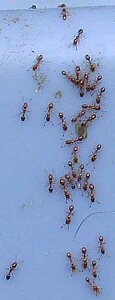 For example, if I observe an ant carrying a seed, it is
just that. Unless I actually see that ant or its nestmates eating that seed,
I cannot say that the ant is carrying a piece of food. Perhaps that seed is
merely in the way and being removed, perhaps it will serve as a substrate
upon which the ants will grow fungus to eat, or perhaps it will serve some
other function. Thus, if I make the “observation” that the ant is carrying a
piece of food, it might lead me to a false conclusion later on that, for
example, the anthill is being invaded by an unwanted fungus. As another
example, “The ants are under the apple slice,” is an observation, but “The
ants are hiding under the apple slice,” or “The ants are looking for food
under the apple slice” are both making unsubstantiated assumptions or drawing
conclusions about the ants’ behavior or their relationship to the apple.
(In Dr. Fankhauser’s photo, these ants were headed into the dog’s food dish.)
For example, if I observe an ant carrying a seed, it is
just that. Unless I actually see that ant or its nestmates eating that seed,
I cannot say that the ant is carrying a piece of food. Perhaps that seed is
merely in the way and being removed, perhaps it will serve as a substrate
upon which the ants will grow fungus to eat, or perhaps it will serve some
other function. Thus, if I make the “observation” that the ant is carrying a
piece of food, it might lead me to a false conclusion later on that, for
example, the anthill is being invaded by an unwanted fungus. As another
example, “The ants are under the apple slice,” is an observation, but “The
ants are hiding under the apple slice,” or “The ants are looking for food
under the apple slice” are both making unsubstantiated assumptions or drawing
conclusions about the ants’ behavior or their relationship to the apple.
(In Dr. Fankhauser’s photo, these ants were headed into the dog’s food dish.)
Also, it is amazing how frequently or how long we can look at
something and never see that which is perfectly obvious about it. This is
the basis of many of our optical illusions. As biologists in a three-dimensional
world of living organisms, we have the opportunity to use our senses of touch,
hearing, and chemoreception to aid our sense of sight, yet we frequently use
only what we see.
Do It!
This lab may be done outdoors (weather permitting), or indoors
if the weather is rainy. Outdoors, there are many living organisms from trees
to smaller plants, insects, birds, etc. Indoors, there are a number of plants
in the greenhouse and out in the hallway. There may also be insects or
spiders in the greenhouse, or perhaps some other animals to be seen.
Pick one of these many organisms, (ant colony, tree, beetle, wildflower, bird,
etc.) and list in your lab notebook at least twenty (20) things you
observe about it. Record descriptive things like its smell, its
sound, how it feels (texture), what it looks like – shape, color,
etc., etc. Be specific on size (how many centimeters?), and don’t just say
it’s “big” or it’ “small” (relative to a blue whale, an elephant is tiny, and
relative to an eyelash mite, an ant is huge).
Don’t worry if you don’t know what this organism is called – actually,
knowing what it is might bias you and tempt you to make conclusions instead
– but do think about what traits/characteristics of that organism might be
distinguishing features you could potentially use to identify it (How many
legs does it have? How are its leaves arranged?). Be careful you do not
include any conclusions among your observations. You may find that the first
two or three observations are “easy” and then it gets harder to think of
things – that’s normal. Just sit there and think a while, and often, a
number of new observations will suddenly come to you. Drawing a picture of
your organism would probably help you to “see” it better, providing you
really look at it to see how to draw it and not just think, “I can’t draw,”
and make only a quick sketch. Especially with plants, remember to observe
the whole organism not just a portion of it. For plants in the greenhouse,
the fact that the plant is in a pot (as opposed to the ground) and the size
of the pot relative to the size of the plant may be “significant”
observations that relate to the plant, but things such as the color and shape
of the pot are observations of the pot, not the plant, and as such,
would most-likely be totally irrelevant to the plant, itself.
Follow-Up at Home
Other Things to Include in Your Notebook
Make sure you have all of the following in your lab notebook: